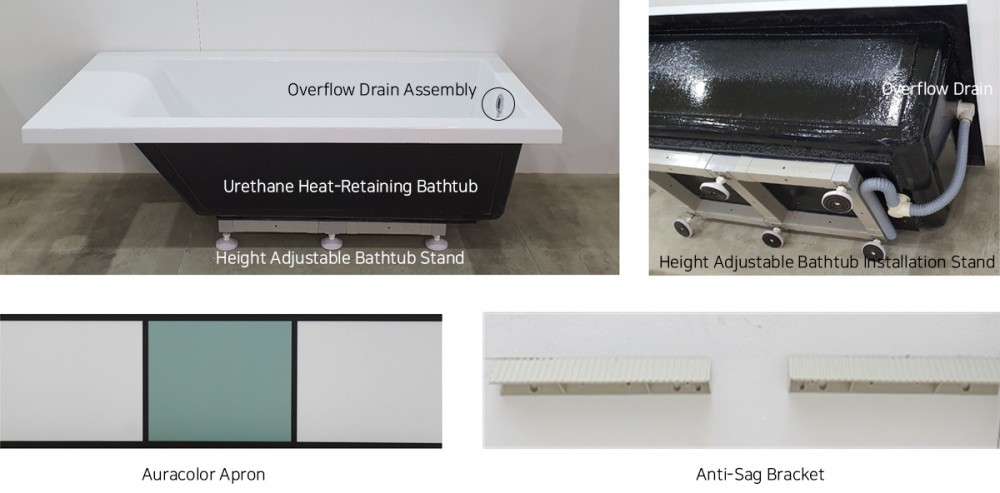Insulated Bathtub Ecova 104
| Certification | The one and only heat-retaining bathtub engineered with patented technology. |
|---|
List
본문
This is the only heat-insulating bathtub made with patented technology.

1. Size Options
- 1500x750x420(H) – Can be installed in lengths from 1400 to 1500 mm.
- 1600x800x420(H) – Can be installed in lengths from 1500 to 1600 mm.
- 1750x800x420(H) – Can be installed in lengths from 1600 to 1750 mm.
* The bathtub will be custom-cut to fit the actual measurements of the site, and the apron will be fabricated accordingly.
* When placing an order, it is recommended to order a size larger than the actual measurement to allow for cutting.
2. Manufacturing Process of the ECOBA Insulated Bathtub
① Material of the Bathtub
We use non-toxic, multi-layered acrylic sheets (PMMA + ABS).
(Ceramic bathtubs and SMC bathtubs made with FRP resin are not non-toxic. For products used over long periods, it is essential to use non-toxic materials to avoid skin irritation.)
(Countries with advanced bathroom cultures—such as Europe, the U.S., and Japan—commonly use acrylic bathtubs.)
② Forming Process: Vacuum Molding
a. 5mm thick acrylic sheets are heated using ceramic heaters that allow precise, zone-controlled heating.
(Fine-tuned heat control directly affects the quality of the bathtub.)
b. To ensure high product quality, we use aluminum molds in the production process.
c. When molding bathtubs with thermoplastic acrylic sheets, sufficient curing time is essential to produce a high-quality product.
ECOBA bathtubs are limited to 30–40 units per day to maintain quality, whereas conventional manufacturers often produce up to 80 units per day.
③ Reinforcement Process: Polyurethane Insulation
a. We use eco-friendly, high-insulation polyurethane, applied in four reinforced stages for enhanced thickness and performance.
(Thickness: Bottom – 35mm / Sides – 18mm)
b. This 4-stage polyurethane spray reinforcement and insulation process is patented.
(Korean Patent No. 10-1470366)
c. In contrast, conventional acrylic bathtubs reinforced with FRP have no insulation performance, only structural support.
They are typically reinforced more thinly (Bottom – 18mm / Sides – 6mm), resulting in poor heat retention and a hollow, unstable feel.
d. Difference in Bottom Reinforcement Materials
ECOBA Insulated Bathtubs:
We produce our own 20mm thick reinforcement boards by crushing and recycling acrylic scraps and defective products generated during manufacturing.
Conventional Acrylic Bathtubs:
Use MDF boards, which are vulnerable to moisture and humidity, often resulting in delamination at the bottom over time.

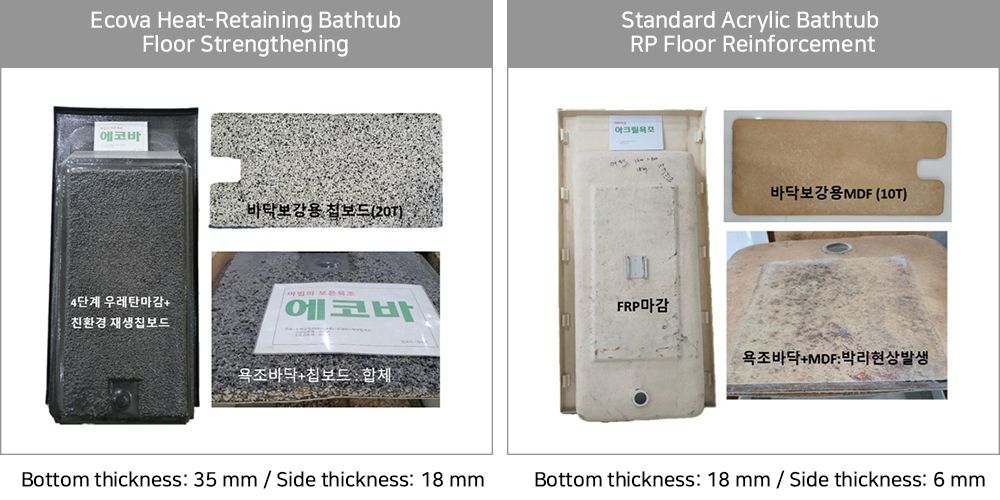
3. ECOBA Insulated Bathtub Performance Test

Hotel Supply – Currently installed and in use at over 2,500 locations nationwide, including the Shilla Stay hotel chain.
How to Use the Insulated Bathtub More Efficiently
※ For better heat retention, we recommend using a bathtub cover or a bathtub shelf, such as a bookrest tray, when using the insulated bathtub.

4. Optional Items
① Apron (Front Panel) – Transform your bathroom with creative materials and design.
Made not from plastic, but from premium materials such as an aluminum frame and metal board.
Design Patent No.: 30-1277466

② Bathtub Accessories
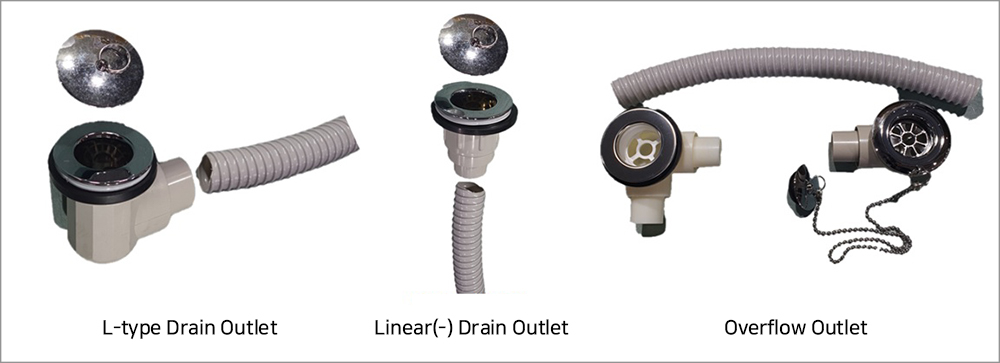
③ Accessories for Dry Installation
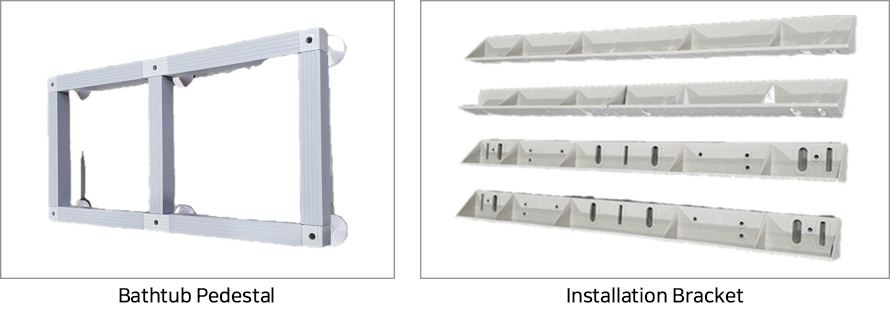
④ Additional Products

⑤ Packaging

⑥ ECOBA Insulated Bathtub Installation Method
1. Wet Installation – The bathtub is fixed in place and leveled using bricks and mortar.
Issues with Wet Installation:
1) Poor fixation due to material incompatibility between cement mortar and bathtub finish material (FRP).
2) The enclosed space beneath the bathtub remains humid, leading to mold growth and unpleasant odors, which can be harmful to health.
3) Bathtub replacement requires specialized labor, incurring high costs and long lead times.
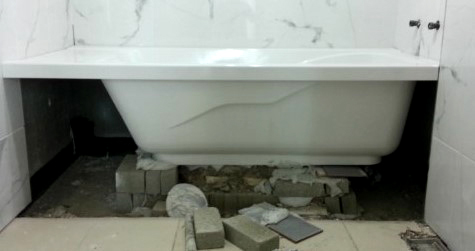
2. Dry Installation – The bathtub is easily set up using a bathtub support frame and height-adjustable feet, similar to a movable bathtub.
Limitations of Standard Acrylic Bathtubs for Dry Installation:
Conventional acrylic bathtubs have thin bottoms and tend to wobble, making them unsuitable for dry installation.
However, the ECOBA Insulated Bathtub is reinforced with a 4-layer structure and a bottom thickness of 35mm or more, eliminating wobbling and providing excellent heat retention.
Advantages:
When replacing the bathtub, only the silicone seal needs to be removed, making installation and replacement easy for anyone.

Components of Dry Installation Bathtub
Types of Bathtubs by Material
Type |
Raw Material |
Manufacturing Method |
Advantages |
Disadvantages |
Acrylic Bathtub |
- Acrylic (PMMA) Sheet - Acrylic (PMMA) Sheet + ABS = Multi-Layer Sheet |
1. Molding 2. Vacuum Forming 3. Back Reinforcement (F.R.P.) |
1. Durability and High Surface Gloss 2. Lightweight and Easy to Handle 3. Widely Used in Europe and the USA |
Sensitive to Hot Water (Above 50℃) |
Ceramic Bathtub (Marble Bathtub) |
Synthetic Resin + Stone Powder + Gelcoat |
1. Molding 2. Mixing raw materials, applying them to the mold, curing, and then demolding |
Wide Design Variety and Easy Accessibility |
1. Heavy and Prone to Impact Damage 2. Cold Surface and Prone to Discoloration 3. Environmentally Unsuitable Raw Materials (Not Used in Developed Countries) |
SMC Bathtub (Silky Bathtub) |
Synthetic Resin + Glass Powder |
1. Molding 2. Compressing and producing the raw materials using a large press |
1. Cost-effective due to Mass Production 2. Lightweight and Easy to Handle |
1. Environmentally Unfriendly Raw Materials(Not used in developed countries or by domestic construction companies) 2. Prone to Damage |
Cast Iron Bathtub (Enamel + Iron Plate) |
Iron Plate + Enamel |
1. Molding 2. Iron plate is produced using a large press, followed by enamel coating 3. Molten iron is poured into a mold to create the bathtub |
1. Durable 2. Good Stability |
1. Heavy 2. Expensive 3. Cannot Be Customized for Site-Specific Sizes |
Hinoki Bathtub (Cypress Wood Bathtub) |
Hinoki (Cypress Wood) |
1. Wood Processing 2. Assembly |
1. Hinoki's Unique Fragrance and Oil Relieve Skin Troubles and Stress 2. High Preference for Natural Wood and Good Insulation |
1. Expensive 2. Difficult to Maintain |







